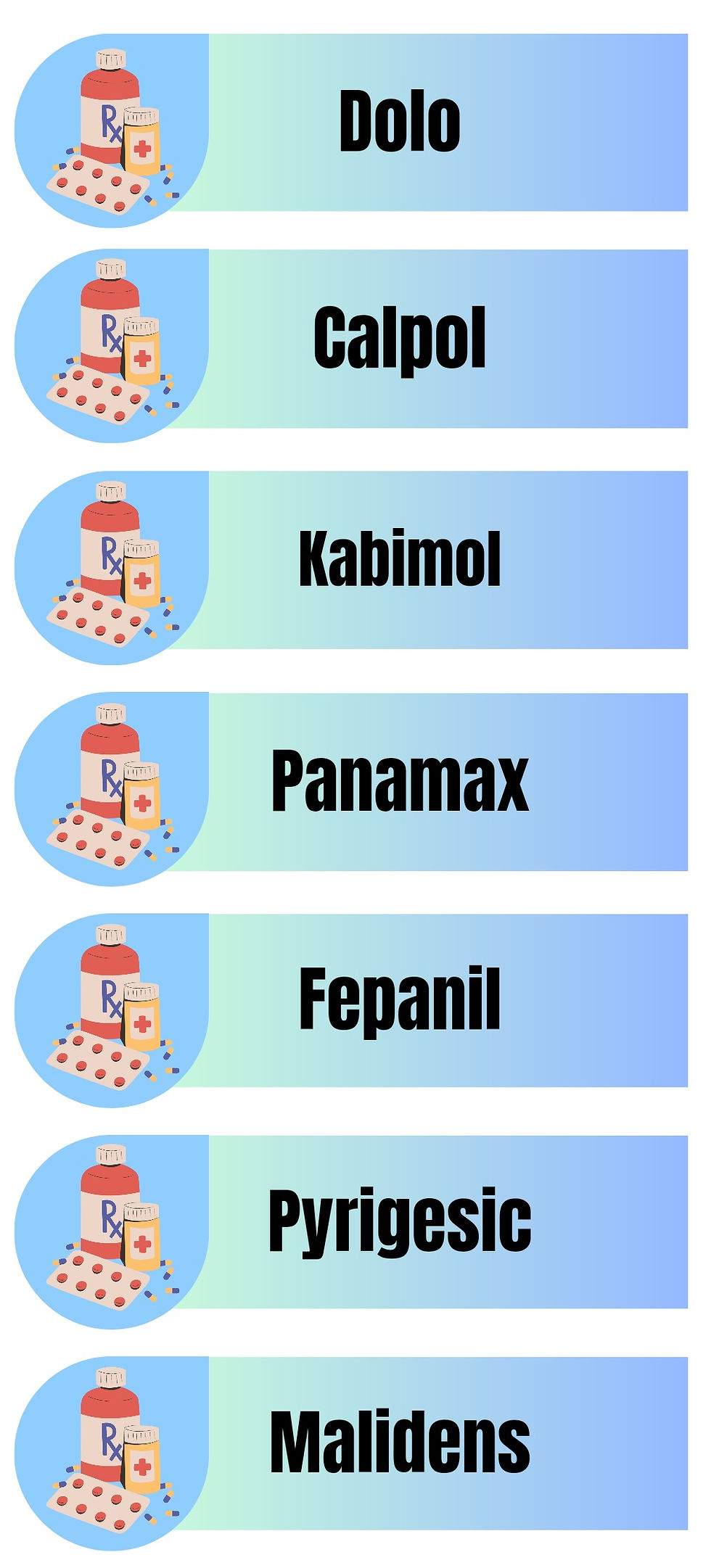PARACETAMOL
- Shravani Kulkarni
- Apr 18, 2023
- 3 min read
Updated: Jun 27, 2023

Category - Antipyretic
Introduction:
Paracetamol Or Acetaminophen is one of the most popular and most commonly used medicines. It is both antipyretic and anti-analgesic. This medicine is used for the treatment of fever and mild to moderate pain. It is also constructively used for Post-surgical pain.
There are various types of Paracetamol such as tablets, capsules, liquid (usually for children), soluble tablets, and an injection given into a vein normally only used in hospitals.
Uses :

How to Use :
Paracetamol should be taken as per prescribed by a doctor.
For every young child, Paracetamol liquid is given using a measured spoon or an oral syringe.
Children should take lower doses depending on their age or weight.
Adults can take 1 or 2 Tablets (500mg) every 4 - 6 hours but shouldn't take more than 4g (500mg x 8) in the space of 24 hours.
Duration between two doses :
Paracetamol can take 1 hour to work
Barely consume 7 tablets, not more than that.
If you are taking Paracetamol for a short-lived pain like a headache you may only need to take it at least for a day or two.
Taking too much Paracetamol medicine can be threatened and you may need treatment.
Store at the room temperature keep it away from moisture and heat.
Side Effects :
Some common side effects can be seen after taking Paracetamol:

An allergic reaction can cause swelling and rash
When paracetamol is injected in a vein in your arm there may be flushing and low blood pressure can occur sometimes
Liver and kidney damage if you consume too much Paracetamol.
Drowsiness and fatigue.
Drug Mechanism:
Pharmacokinetics: Paracetamol is absorbed from the digestive tract and reaches plasma concentrations 10-60 minutes after oral administration. It is distributed in most body tissues and has a half-life of 1-3 hours. The liver breaks down paracetamol, which is mostly eliminated in urine as inactive sulphate conjugates and glucuronide. Overdose can lead to irreversible liver damage. Preterm newborns, infants, and early children have different metabolisms, with sulphate conjugates predominant. Pharmacodynamics: Paracetamol is a derivative of p-aminophenol that exhibits antipyretic and analgesic activity. No anti-inflammatory effect. Paracetamol is thought to induce analgesia through central inhibition of prostaglandin synthesis.
Safety Measures :

When to see the doctor:
When you take an overdose of paracetamol or have no effect, seek an immediate doctor there are some following symptoms to rush immediately to the doctor-
Abdominal pain.
Nausea.
Vomiting.
Liver problems.
Seizures.
Allergic reactions:
This drug can cause severe allergic reactions. Symptoms include :

● Rash and swelling
● Low blood pressure
● Blood disorders such as thrombocytopenia and leukopenia.
● Liver and kidney damage (if over use of medicine takes place).
Available Dosage form:
Tablets
Strength : 325mg to 500mg
Capsules
Strength : 500mg
Suspension
Strength: 160mg Or 5ml
Pediatric (Child dosage) :
For Infants;
Take 10mg to 15mg per kilogram per dosage every 4 to 6 hours period. Barely 75 mg per kilogram per day may be given in a day.
Paracetamol pediatric oral suspension : 125mg per 5ml; 250ml per 5ml; in case of pediatric drops 100mg per ml and 150 mg per ml.
For children: Considering less than 50kg, dosages of 10 to 15 mg per kilogram per dose may be given every 4 to 6 hours period. Separate doses should not exceed 15 mg per kilogram per dose (or 1000 mg per dosage).
Adult dosage:
A 650 mg medicinal dose can be taken every 4 to 6 hours daily or as per prescription (i.e. within a 24-hour period). If dosages are taken at a day, medical supervision is generally advised.
Important Note :
The drug is recommended for pregnant and breastfeeding women
A very severe allergic reaction to this drug is infrequent.
Liquid products, effervescent tablets Or chewable products and powders may contain sugar.
Care should be taken if you have diabetes, phenylketonuria (PKU), or any other condition that requires you to limit/avoid these substances in your diet. Please consult your doctor or pharmacist about the safe use of this product.
Various brands :

Reference :
Medically reviewed by Philip Thornton, DipPharm.
Marta Jóźwiak-Bebenista et al. Acta Pol Pharm.
Jeffrey L. Finnan, Rudolph E. Lisa, Douglass N. Schmidt, "Process for preparing spray dried acetaminophen powder and the powder prepared thereby." U.S. Patent US4710519, issued October, 1975.
Indian pharmacopoeia.

Information Easy to understand.... helpful...!!!
This is very informative and wisely written.